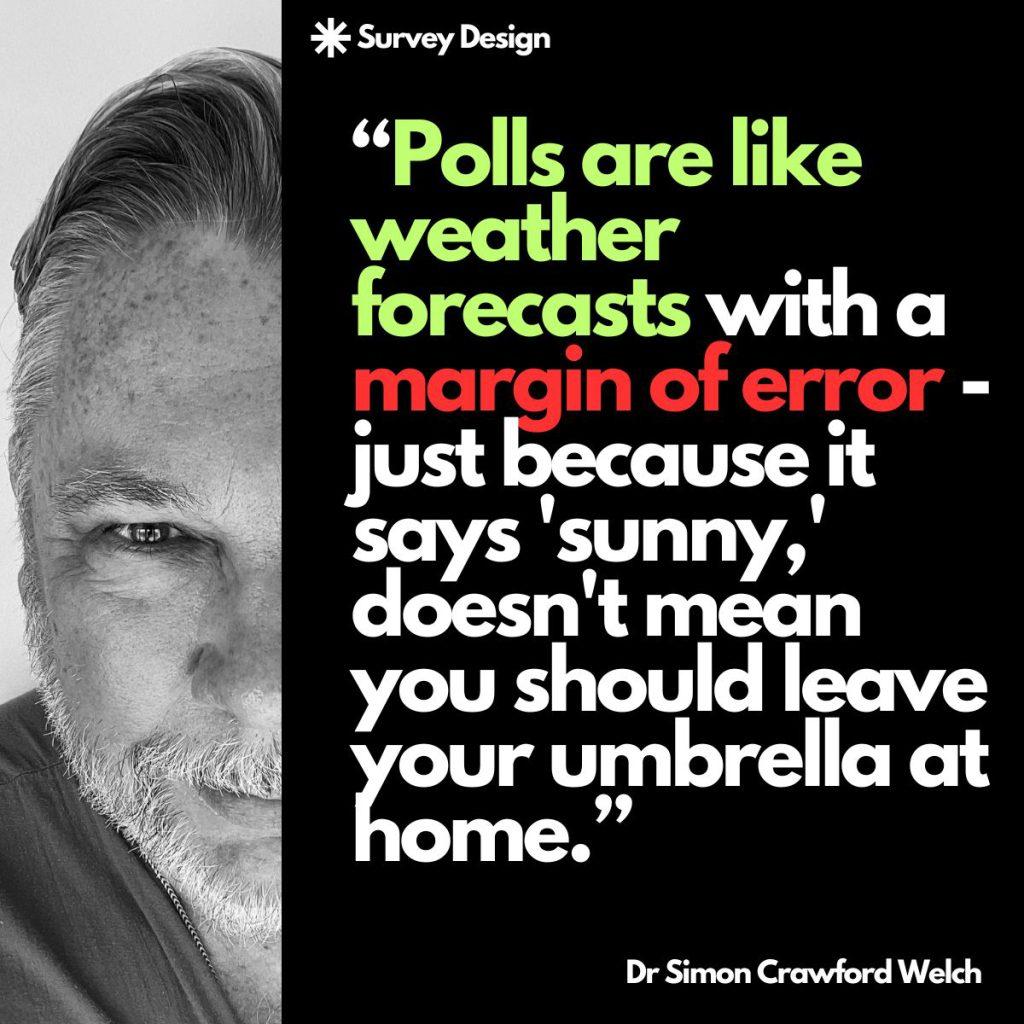A Critical Look as Election Day Approaches
By Dr. Simon Crawford-Welch
Founder, The Critical Thought Lab
Follow me at www.linkedin.com/in/simoncrawfordwelch
As we approach the final stages of a Presidential election, the airwaves are flooded with poll results. It’s like every other day we’re hearing how one candidate is ahead by a few points, or maybe they’ve lost ground in a key battleground state. But how much weight should we actually give to these numbers? The key to understanding these figures lies in a little phrase you’ve probably heard a lot but might not fully grasp: the “margin of error.”
Let’s break down what this means and why it’s so crucial—especially when the stakes are as high as they are in a Presidential election.

What Exactly is Margin of Error?
When you hear that a poll shows Candidate A leading Candidate B by 3 points, with a margin of error of ±4%, what does that really mean? Simply put, the margin of error tells you how much the poll results might differ from the actual opinion of the entire population. It’s a measure of the poll’s accuracy.
Let’s say you have a poll with a margin of error of ±4%. If Candidate A is polling at 50%, this means the true support for Candidate A could be as high as 54% or as low as 46%. That’s a pretty big swing! This range of possible outcomes means that if two candidates are close in the polls, the margin of error could mean the difference between who’s really leading and who’s trailing.
Why Does the Margin of Error Matter?
In the final days leading up to an election, every percentage point seems crucial. But the margin of error can cast a shadow of doubt over the seemingly clear picture that polls often present. A poll might show Candidate A leading Candidate B by 2 percentage points, but if the margin of error is ±3%, this lead isn’t statistically significant. In other words, it’s a toss-up—Candidate B could very well be ahead. Understanding this can prevent misinterpretations and misplaced confidence based on polling data.
The Sample Size Dilemma
The margin of error is largely influenced by the sample size of the poll. The larger the sample, the smaller the margin of error, and vice versa. This is why you’ll often hear about polls that survey thousands of people rather than just a few hundred. It’s simple math: more people polled equals more reliable results.
However, even with a large sample size, there’s no guarantee that the sample perfectly represents the broader population. Pollsters attempt to account for this by weighting their results—adjusting the data to reflect the population’s demographics, like age, race, gender, and political affiliation. But these adjustments can sometimes introduce their own biases, which could further complicate the margin of error.
Real-World Examples of Misinterpreted Polls
Here’s some historical examples where misunderstanding or ignoring the margin of error led to big surprises.
The 1948 Presidential Election
One of the most famous polling blunders in U.S. history occurred during the 1948 Presidential election between Harry Truman and Thomas Dewey. Polls had Dewey comfortably ahead, so much so that many media outlets predicted his victory long before Election Day. The Chicago Tribune famously ran the headline “Dewey Defeats Truman” before the votes were fully counted. However, Truman won the election by a significant margin.
The problem? Pollsters had stopped surveying voters weeks before the election, missing a late surge in support for Truman. Moreover, the margin of error was largely ignored, leading to overconfidence in Dewey’s lead.
The 2016 Presidential Election
Fast forward to the 2016 election, and we see a more recent example of how misunderstanding margin of error can lead to shock and surprise. Most polls showed Hillary Clinton leading Donald Trump nationally by a few percentage points. And indeed, she did win the popular vote by around 2.1%. However, the margin of error in key swing states was often overlooked or misunderstood.
For instance, in states like Michigan, Wisconsin, and Pennsylvania, where Trump won by less than 1%, the margin of error in polls was often around ±3-4%. This means the race in these states was much closer than many realized, making Trump’s path to victory more plausible than it seemed.
The Brexit Vote
Let’s take a quick detour across the Atlantic to the 2016 Brexit referendum in the UK. Polls leading up to the vote suggested a close race, with a slight edge for the “Remain” camp. However, the “Leave” side won by a narrow margin. Here, the margin of error played a crucial role—pollsters, and by extension the public, underestimated the uncertainty in the polling data, leading to widespread surprise at the outcome.
The Psychological Impact of Polls and Margin of Error
Polling data doesn’t just inform us; it can influence us. People often fall into the trap of thinking of poll results as definitive when in fact they are snapshots of a moment in time, influenced by who was surveyed, when, and how. The margin of error is a reminder that poll numbers are not exact figures but ranges with a degree of uncertainty.
This psychological impact was evident in the 2016 U.S. election, where many voters, seeing Clinton ahead in the polls, may have felt less urgency to vote. After all, if your candidate is winning, why bother standing in a long line at the polls? But as we saw, the margin of error meant those leads were less secure than they appeared.
Polling Aggregators and Margin of Error
One way to mitigate the impact of the margin of error in any single poll is by looking at polling aggregators like FiveThirtyEight or RealClearPolitics. These sites compile data from multiple polls, smoothing out individual polling errors and providing a more accurate picture of the race. However, even these aggregators can’t fully eliminate the margin of error—it’s still present, just reduced. It’s also worth noting that aggregators weigh polls differently based on their methodology, sample size, and historical accuracy, which can introduce its own form of bias.
The Final Days and the Need for Caution
As we approach the finish line in any election, it’s more important than ever to understand what poll numbers actually represent. The margin of error is a critical piece of this puzzle. It reminds us that no poll is a perfect reflection of reality—there’s always some uncertainty. When polls show a tight race, the margin of error suggests we should be prepared for anything on Election Day.
In the end, while polls can provide valuable insights, they are not crystal balls. They offer a glimpse into the electorate’s mood but should be interpreted with caution, especially as we move into the final days before the vote. By keeping the margin of error in mind, we can better understand the limitations of polling and avoid the pitfalls of overconfidence or unwarranted despair based on the latest numbers flashing across our screens.
So, the next time you hear that Candidate A is up by 3 points, remember: there’s more to the story than just the numbers. The margin of error is telling us to stay tuned—because in politics, as in life, almost anything can happen.



